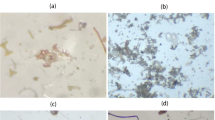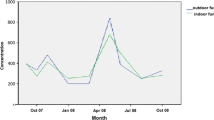Abstract
Purpose
The aim of the study was to evaluate exposure to moulds and house dust mite Dermatophagoides pteronyssinus in poultry farms, and related health effects in poultry workers (PW).
Methods
The study involved 41 PW and 45 control office workers. Working environment was evaluated for D. pteronyssinus allergen (Der p 1), moulds and endotoxin. In workers, eye, skin and respiratory symptoms, ventilatory lung function, atopy markers (skin prick test to inhalatory allergens, total IgE) and specific IgG to moulds were assessed.
Results
Der p 1 levels ranged <0.1–3.3 μg/g, exposure to fungi was 4.9 × 103–6.8 × 104 cfu/m3, with prevailing Aspergillus, Penicillium and Mucor species, and endotoxin levels ranged 230–284 EU/m3. In comparison to control subjects, significantly higher prevalence of work-related nose, asthma, eye and skin symptoms, and slight decline in ventilatory lung function was found in PW. PW had significantly higher prevalence of IgG antibodies to moulds comparing to controls (63 vs. 36%, respectively, P = 0.01), especially to Alternaria and Aspergillus species. The prevalence of atopy markers in PW was lower than in population-based studies.
Conclusions
Hazardous levels of Der p 1, endotoxin and moulds were determined in poultry houses. High prevalence of work-related symptoms and IgG antibodies to moulds was found in PW. Healthy worker effect is proposed as an explanation of low atopy markers prevalence among PW.


Similar content being viewed by others
References
Aberer W, Kranke B (2002) Measurement of IgE antibodies using liquid allergens—an inter-method and inter-laboratory quality assessment. Wien Klin Wochenschr 114:929–937
Anonimus (1998) MERCK MAS–100 system. Microbiological air sampler, operator’s manual. MERCK KgaA, Darmstadt, Germany
Anonymous (1987) Guideline on validation of the Limulus amebocyte lysate test as an end-product endotoxin test for human and animal parenteral drugs, biological products and medical devices. US Food and Drug Administration, US Department of Health and Human Services, US Public Health Service, USA
Bünger J, Antlauf-Lammers M, Schulz TG, Westphal GA, Müller MM, Ruhnau P, Hallier E (2000) Health complaints and immunological markers of exposure to bioaerosols among biowaste collectors and compost workers. Occup Environ Med 57:458–464
Clark S, Rylander R, Larsson L (1983) Airborne bacteria, endotoxin and fungi in dust in poultry and swine confinement buildings. Am Ind Hyg Assoc J 44:537–541
Do R, Bartlett KH, Dimich-Ward H, Chu W, Kennedy SM (2008) Biomarkers of airway acidity and oxidative stress in exhaled breath condensate from grain workers. Am J Respir Crit Care Med 178(10):1048–1054
Dreborg S (1998) Mite allergens. Collection, determination, expression of results and risk levels for sensitization and symptom induction. Allergy 53(48 Suppl):88–91
Dreborg S, Frew A (1993) Position paper: allergen standardization and skin tests. Allergy 48(14 Suppl):49–82
Drexler H, Schaller KH, Nielsen J, Weber A, Weihrauch M, Welinder H, Skerfving S (1999) Efficacy of measures of hygiene in workers sensitised to acid anhydrides and the influence of selection bias on the results. Occup Environ Med 56:202–205
Fireman E, Lerman Y, Stark M, Schwartz Y, Ganor E, Grinberg N, Frimer R, Landau DA, Zilberberg M, Barenboim E, Jacovovitz R (2008) Detection of occult lung impairment in welders by induced sputum particles and breath oxidation. Am J Ind Med 51(7):503–511
Halonen M, Stern DA, Wright AL, Taussig LM, Martinez FD (1997) Alternaria as a major allergen for asthma in children raised in desert environment. Am J Respir Crit Care Med 155:1356–1361
Hollander A, Heederik D, Doekes G (1997) Respiratory allergy to rats: exposure–response relationships in laboratory animal workers. Am J Respir Crit Care Med 155:562–567
Horner WE, Helbling A, Salvaggio JE, Lehrer SB (1995) Fungal allergens. Clin Microbiol Rev 8:161–179
Johansson SGO, Bieber T, Dahl R et al (2004) Revised nomenclature for allergy for global use: report of the nomenclature review committee of the World allergy organization, October 2003. J Allergy Clin Immunol 113:832–836
Kogevinas M, Anto JM, Sunyer J, Tobias A, Kromhout H, Burney P (1999) Occupational asthma in Europe and other industrialized areas: a population based study. Lancet 353:1750–1754
Lemiere C (2007) Induced sputum and exhaled nitric oxide as noninvasive markers of airway inflammation from work exposures. Cur Opin Allergy Clin Immunol 7(2):133–137
Lugauskas A, Krikštaponis A, Šveistyte L (2004) Airborne fungi in industrial environments-potential agents of respiratory diseases. Ann Agric Environ Med 11:19–25
Macan J, Kanceljak B, Plavec D, Milković-Kraus S (2003) Differences in mite fauna between the continental and Mediterranean climates of Croatia: microscopy and Dustscreen™ test findings. Allergy 58:780–783
Macan J, Kanceljak-Macan B, Mustač Marko, Milković-Kraus S (2005) Analysis of dust samples from urban and rural occupational environments in Croatia. Arh Hig Rada Toksikol 56:327–332
Macan J, Varnai VM, Maloca I, Kanceljak-Macan B (2007) Increasing trend in atopy markers prevalence in a Croatian adult population between 1985 and 1999. Clin Exp Allergy 37:1756–1763
Munivrana H, Vorko-Jović A, Munivrana S, Kursar M, Medlobi-Gluhak M, Vlahek P (2007) The prevalence of allergic diseases among Croatian school children according to the ISAAC Phase One questionnaire. Med Sci Monit 13(11):CR505–CR509
Novak D (1994) Prevalence and risk factors for airway diseases in farmers: a new EC multicentre project. Ann Agric Environ Med 1:81–82
Omland O (2002) Exposure and respiratory health in farming in temperate zones–a review of the literature. Ann Agric Environ Med 9:119–136
Ostro B, Lipsett M, Mann J, Braxton-Owens H, White M (2001) Air pollution and exacerbation of asthma in African-American children in Los Angeles. Epidemiology 12:200–208
Ouchterlony O (1958) Diffusion in gel. Methods for immunological analysis. Progr Allergy 55:1–78
Portengen L, Hollander A, Doekes G, de Meer G, Heederik D (2003) Lung function decline in laboratory animal workers: the role of sensitisation and exposure. Occup Environ Med 60(11):870–875
Prester LJ, Brčić Karačonji I, Macan J (2007) Determination of mite allergens in house dust using the enzyme immunoassay. Arh Hig Rada Toksikol 58:413–419
Quanjer PH, Tammeling GJ, Cotes JE, Pedersen OF, Peslin R, Yernault JC (1993) Lung volumes and forced ventilatory flows. Report working party standardization of lung function tests, European community for steel and coal. Official statement of the european respiratory society. Eur Respir J Suppl 16:5–40
Radon K, Danuser B, Iversen M, Jörres R, Monso E, Opravil U et al (2001a) Respiratory symptoms in European animal farmers. Eur Respir J 17:747–754
Radon K, Weber C, Iversen M, Danuser B, Pedersen S, Nowak D (2001b) Exposure assessment and lung function in pig and poultry farmers. Occup Environ Med 58:405–410
Radon K, Danuser B, Iversen M, Monso E, Weber C, Hartung J et al (2002) Air contaminants in different European farming environments. Ann Agric Environ Med 9:41–48
Rylander R, Carvalheiro MF (2006) Airways inflammation among workers in poultry houses. Int Arch Occup Environ Health 79:487–490
Rylander R, Peterson Y, Donham KJ (1990) Questionnaire evaluating organic dust exposure. Am J Ind Med 17:121–126
Segvić Klarić M, Pepeljnjak S (2006) A year-round aeromycological study in Zagreb area, Croatia. Ann Agric Environ Med 13:55–64
Senthilselvan A, Dosman JA, Kirychuk SP, Barber EM, Rhodes CS, Zhang Y et al (1997) Accelerated lung function decline in swine confinement workers. Chest 111:1733–1741
Simell B, Lahdenkari M, Reunanen A, Käyhty H, Väkeväinen M (2008) Effects of ageing and gender on naturally acquired antibodies to Pneumococcal capsular polysaccharides and virulence-associated proteins. Clin Vacc Immunol 15(9):1391–1397
Skorska C, Mackiewicz B, Golec M, Cholewa G, Chmielowiec-Korzeniowska A, Dutkiewicz J (2007) Health effects of exposure to organic dust in workers of a modern hatchery. Ann Agric Environ Med 14:341–345
Spieksma FT (1997) Domestic mites from an acarologic perspective. Allergy 52:360–368
Tabar-Purroy AI, Alvarez-Puebla MJ, Acero-Sainz S, García-Figueroa BE, Echechipía-Madoz S, Olaguibel-Rivera JM, Quirce-Gancedo S (2003) Carmine (E-120)–induced occupational asthma revisited. J Allergy Clin Immunol 111:415–419
Varnai MV, Macan J, Plavec D, Jureša D (2004) Endotoxin measurement in house dust using the end-point limulus amebocyte lysate method. Arh Hig Rada Toksikol 55:175–181
Vučemilo M, Matković K, Vinković B, Macan J, Varnai VM, Prester LJ et al (2008) Effect of microclimate on the airborne dust and endotoxin concentration in a broiler house. Czech J Anim Sci 53:83–89
Zock JP, Heederik D, Doekes G (1998) Evaluation of chronic respiratory effects in the potato processing industry: indications of a healthy worker effect? Occup Environ Med 55(12):823–827
Zuskin E, Mustajbegovic J, Schachter EN, Kern J, Rienzi N, Goswami S et al (1995) Respiratory function in poultry workers and pharmacologic characterization of poultry dust extract. Environ Res 70:11–19
Acknowledgments
The study was done within the scientific projects No. 022-0222411-2410 and No. 053-0531854-1867, financially supported by the Ministry of Science, Education and Sports of Republic of Croatia. Projects were approved by authorized Ethical Committees.
Conflict of interest statement
The authors declare that they have no conflict of interest.
Author information
Authors and Affiliations
Corresponding author
Rights and permissions
About this article
Cite this article
Rimac, D., Macan, J., Varnai, V.M. et al. Exposure to poultry dust and health effects in poultry workers: impact of mould and mite allergens. Int Arch Occup Environ Health 83, 9–19 (2010). https://doi.org/10.1007/s00420-009-0487-5
Received:
Accepted:
Published:
Issue Date:
DOI: https://doi.org/10.1007/s00420-009-0487-5




